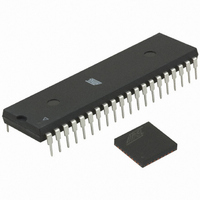ATMEGA64RZAV-10PU Atmel, ATMEGA64RZAV-10PU Datasheet - Page 179

ATMEGA64RZAV-10PU
Manufacturer Part Number
ATMEGA64RZAV-10PU
Description
MCU ATMEGA644/AT86RF230 40-DIP
Manufacturer
Atmel
Series
ATMEGAr
Datasheets
1.ATMEGA644-20MU.pdf
(23 pages)
2.ATMEGA644-20MU.pdf
(376 pages)
3.AT86RF230-ZU.pdf
(98 pages)
Specifications of ATMEGA64RZAV-10PU
Frequency
2.4GHz
Modulation Or Protocol
802.15.4 Zigbee
Power - Output
3dBm
Sensitivity
-101dBm
Voltage - Supply
1.8 V ~ 3.6 V
Data Interface
PCB, Surface Mount
Memory Size
64kB Flash, 2kB EEPROM, 4kB RAM
Antenna Connector
PCB, Surface Mount
Package / Case
40-DIP (0.600", 15.24mm)
Wireless Frequency
2.4 GHz
Interface Type
JTAG, SPI
Output Power
3 dBm
For Use With
ATSTK600-TQFP32 - STK600 SOCKET/ADAPTER 32-TQFPATAVRISP2 - PROGRAMMER AVR IN SYSTEMATSTK500 - PROGRAMMER AVR STARTER KIT
Lead Free Status / RoHS Status
Lead free / RoHS Compliant
Operating Temperature
-
Applications
-
Data Rate - Maximum
-
Current - Transmitting
-
Current - Receiving
-
Lead Free Status / Rohs Status
Lead free / RoHS Compliant
For Use With/related Products
ATmega64
- Current page: 179 of 376
- Download datasheet (8Mb)
17.8.3
2593N–AVR–07/10
Asynchronous Operational Range
Figure 17-7. Stop Bit Sampling and Next Start Bit Sampling
The same majority voting is done to the stop bit as done for the other bits in the frame. If the stop
bit is registered to have a logic 0 value, the Frame Error (FEn) Flag will be set.
A new high to low transition indicating the start bit of a new frame can come right after the last of
the bits used for majority voting. For Normal Speed mode, the first low level sample can be at
point marked (A) in
(B). (C) marks a stop bit of full length. The early start bit detection influences the operational
range of the Receiver.
The operational range of the Receiver is dependent on the mismatch between the received bit
rate and the internally generated baud rate. If the Transmitter is sending frames at too fast or too
slow bit rates, or the internally generated baud rate of the Receiver does not have a similar (see
Table
bit.
The following equations can be used to calculate the ratio of the incoming data rate and internal
receiver baud rate.
D
S
S
S
R
Table 17-2
that Normal Speed mode has higher toleration of baud rate variations.
F
M
slow
17-2) base frequency, the Receiver will not be able to synchronize the frames to the start
(U2X = 0)
(U2X = 1)
Sample
Sample
RxD
R
slow
and
Sum of character size and parity size (D = 5 to 10 bit)
Samples per bit. S = 16 for Normal Speed mode and S = 8 for Double Speed
mode.
First sample number used for majority voting. S
for Double Speed mode.
Middle sample number used for majority voting. S
S
is the ratio of the slowest incoming data rate that can be accepted in relation to the
receiver baud rate. R
accepted in relation to the receiver baud rate.
=
M
Table 17-3
= 5 for Double Speed mode.
------------------------------------------ -
S 1
–
Figure
(
D
+
1
1
+
D S ⋅
1
2
17-7. For Double Speed mode the first low level must be delayed to
list the maximum receiver baud rate error that can be tolerated. Note
)S
+
3
2
S
F
4
fast
5
3
is the ratio of the fastest incoming data rate that can be
6
7
4
8
STOP 1
9
5
10
R
fast
(A)
0/1
6
=
0/1
F
-----------------------------------
(
= 8 for normal speed and S
D
M
(B)
0/1
0/1
(
+
= 9 for normal speed and
D
1
+
)S
2
)S
+
ATmega644
S
M
(C)
F
179
= 4
Related parts for ATMEGA64RZAV-10PU
Image
Part Number
Description
Manufacturer
Datasheet
Request
R

Part Number:
Description:
DEV KIT FOR AVR/AVR32
Manufacturer:
Atmel
Datasheet:

Part Number:
Description:
INTERVAL AND WIPE/WASH WIPER CONTROL IC WITH DELAY
Manufacturer:
ATMEL Corporation
Datasheet:

Part Number:
Description:
Low-Voltage Voice-Switched IC for Hands-Free Operation
Manufacturer:
ATMEL Corporation
Datasheet:

Part Number:
Description:
MONOLITHIC INTEGRATED FEATUREPHONE CIRCUIT
Manufacturer:
ATMEL Corporation
Datasheet:

Part Number:
Description:
AM-FM Receiver IC U4255BM-M
Manufacturer:
ATMEL Corporation
Datasheet:

Part Number:
Description:
Monolithic Integrated Feature Phone Circuit
Manufacturer:
ATMEL Corporation
Datasheet:

Part Number:
Description:
Multistandard Video-IF and Quasi Parallel Sound Processing
Manufacturer:
ATMEL Corporation
Datasheet:

Part Number:
Description:
High-performance EE PLD
Manufacturer:
ATMEL Corporation
Datasheet:

Part Number:
Description:
8-bit Flash Microcontroller
Manufacturer:
ATMEL Corporation
Datasheet:

Part Number:
Description:
2-Wire Serial EEPROM
Manufacturer:
ATMEL Corporation
Datasheet:










